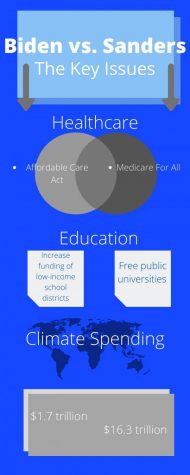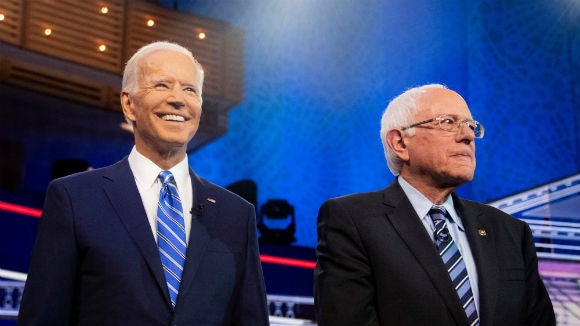Biden vs. Sanders
A comparison of the remaining Democratic candidates: where they stand on issues and the demographics of their supporters
March 11, 2020
The race for the 2020 Democratic nomination is getting slimmer, seemingly by the day. With nearly 20 candidates at one point, the field has narrowed to only two: former Vice-President Joe Biden and senator Bernie Sanders.
Several prominent candidates dropped out recently: Pete Buttigieg, the millennial who centered his campaign on being a new voice and the token non-millionaire (or billionaire); Mike Bloomberg, the wealthy businessman from New York who dubbed himself “the only one who can beat Trump”; and Senator Elizabeth Warren, who held out until just last week before ending her campaign and eliminating any reasonable chance that America will see its first female president. Most who have dropped out have endorsed Joe Biden, although Warren has yet to announce her support for a candidate.
The 2020 presidential election will be a big one — regardless of the winner, there will likely be more chaos, maybe protests, maybe just angered Twitter users. It will be monumental.
After Super Tuesday, the Biden and Sanders were polling close, though Biden appeared to be pulling ahead. Biden’s lead only increased after the primaries held on March 10th.
According to CNN’s 2020 Primary Exit polls, Biden and Sanders attract different demographics of voters, and while the statistics differ between states, there are trends that will likely continue for the remaining primaries. Biden tends to win a greater percentage of voters ages 45 and older, while Sanders appeals to more voters ages 18-44. Additionally, Biden holds more support from black voters, while Hispanic voters typically lean towards Sanders.
Additionally, the two remaining Democratic candidates have very different bases for their campaign. In the South Carolina debate, Biden stated “The people know me. My entire career has been wrapped up in dealing with civil rights and civil liberties.” Biden relies on his experience as VP during the Obama administration, while Sanders has set forth plans for radical changes in America, sticking to his democratic socialist views.
Sanders’ advocacy for democratic socialism is the main concern for most of his critics. He is typically associated with socialism, as opposed to democratic socialism, but these two forms of government have different definitions and political ideologies. Socialism is “a system of social organization in which private property and the distribution of income are subject to social control.” Sander’s ideology of democratic socialism, according to Business Insider, generally believes that “the government should help provide for people’s most basic needs and help all people have an equal chance at achieving success,” which other developed countries like Germany, France, Norway, and Sweden already follow.

Sanders’ plans for universal healthcare and tuition-free college are based on his democratic socialist views, a heavily criticized aspect that leaves Americans wondering how these industries will be funded. His response to the criticism is that he is “presenting an agenda that works for the working people of this country, not the billionaire class,” a statement he made during the South Carolina Democratic Primary Debate.
Biden, on the other hand, plans to make moderate changes to the existing policies, especially by keeping the Affordable Care Act implemented in 2009 and expanding Medicaid. Across the board, from health care to economic policy, There is no question that he is seen as the more moderate Democrat in contention.
In regard to education, Sanders wants to implement a $60,000 minimum salary for school teachers and promotes his “college for all” plan to eliminate student loan debt and allow free tuition at public universities. Biden also wants to reduce the cost of higher education, but his main focus is increasing funding for low-income districts.
As climate becomes an ever pressing topic of discussion, Biden and Sanders both support the Green New Deal and plan to spend generous money on protecting the environment. Sanders specifically outlines a goal of reversing climate change effects within the decade. His plan will cost $16.3 trillion dollars and move the country towards 100% renewable energy, while Biden proposes only $1.7 trillion, and emphasizes eliminating greenhouse gas emissions.
While both candidates have opposing views on some important issues, it is unknown what will happen in the future. Biden can continue his lead, but the outcome remains uncertain. The next debate, in Phoenix, Arizona on March 15th, will be strictly focused on the two candidates and will likely have no small impact on whom voters choose.













